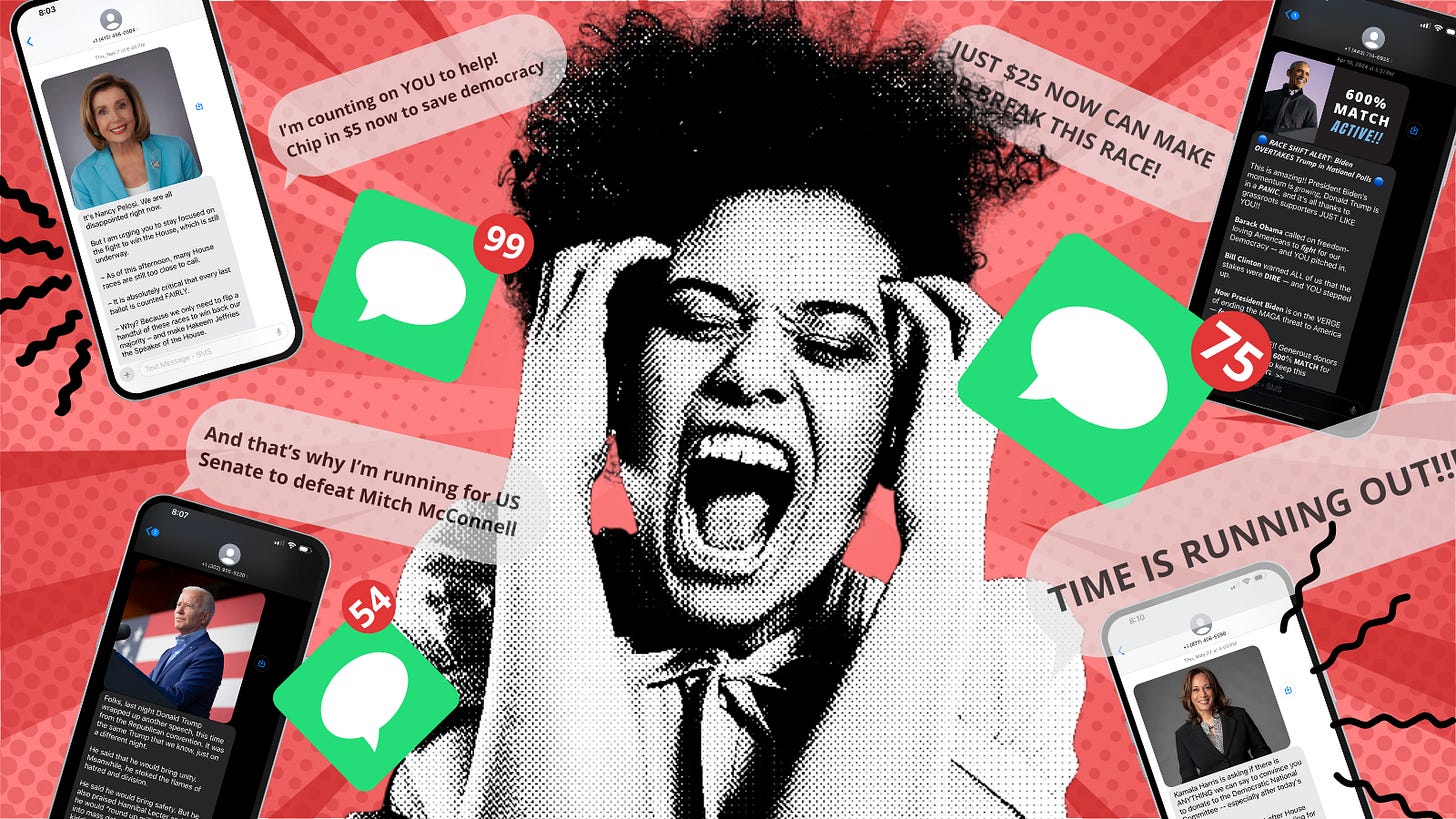We Get It, Nancy. You’re Worried.
How Dems are losing the digital fundraising war and our voters through text.
Let’s talk about something that is all too common these days:
Phone buzzes.
New SMS Message from +5718439289
“Matthew-
This is Nancy Pelosi. You won’t believe what I just heard. We are down two points in your state. We need you to rush $5 now to help us close the gap or democracy as we know is over. Can you give to Blue Progress Forward PAC now?
Text STOP to quit”
Ugh. Text STOP. Swipe. Junk.
Phone buzzes.
“Hey friends! My name is Alex and I am a volunteer with XYZ Organization. We need your help by sending us…”
STOP. Delete.
Phone buzzes.
“MATT-
This is [Democratic Primary Candidate You Never Heard Of In 4 Way Primary] and I’m running to unseat [Entrenched Republican in a R +30 Seat in a State You Don’t Live In]. Your contribution now will make or break our fight against fascism and will help defeat Donald Trump. Can you chip in $25 now?”
Look, I’ll admit it. These tactics were effective at one point. I would know—I used them myself. When those ActBlue numbers start rolling in, it’s hard to stop. But that was six years ago.
We’ve been sending the same "OH NO the sky is falling and America is dying" emails and texts for almost a decade. Instead of evolving our messaging, we leaned on it like a crutch. Now, a vast array of scam PACs use the same tactics. The result? An endless barrage of alarmist messages that voters no longer believe.
Voters now receive hundreds of texts a day filled with language that doesn’t match polling. They’re annoyed. They tune out.
Among political insiders, it’s become a running joke. We text each other screenshots of messages featuring Nancy Pelosi’s face, asking if we want to go out for drinks. We laugh at mass texts pretending to be about splitting a dinner bill.
Yes, politics takes money. Everyone knows that. Technology has made it easier than ever to fundraise—no more thousands of calls or hundreds of events to raise a fraction of what digital can. But just as technology evolves, so must our tactics.
The Human Element
What we’ve lost in the rise of technology is relationship-building with our donors and voters. Person-to-person contact has become impersonal—broadcast texting, email listservs, templated social media posts. We no longer try to build trust with the people we’re asking to support us.
In any other field, investors are shown work products or reports explaining how their money is used. Most candidates include a short bio or passionate appeal, but let me speak for many Millennials and Gen Zers: when a text message the length of a novel hits my phone, I panic. Long texts feel like they’re from a friend you're fighting with, a partner breaking up with you, or a parent delivering bad news.
And when it’s from someone you don’t know asking for money? You’re not going to read it.
When people only hear from campaigns asking for money—especially if results are unclear or always pending "just a little more"—they lose trust. We must foster long-term relationships. A human touch could turn a one-time donor into a lifetime supporter.
The Sensationalization of Digital Messages
"Democracy is ending. Can you rush $5?"
"OH MY GOD! I can’t believe what I just heard. Donald Trump just said this and it could destroy our country."
"We’re losing, friend. Your $25 contribution could make or break this election. But you haven’t given yet."
"We’ve texted you so many times. Is there anything else I can say to make you care?"
Sound familiar?
During Trump’s first presidency, the doom-and-gloom worked. Fear is a powerful motivator. But now, it has two major consequences.
First, voters are smarter than we give them credit for. They know that not every election can truly be the "most consequential in our lifetimes." They follow news, social media, podcasts. So when they see a message that says, "We're losing," but they just saw polls showing us ahead, they feel insulted.
When we claim, "We have no money," while the media reports record-breaking campaign spending, they feel lied to or think we’re bad with money.
Second, some voters trust us—and that’s actually a problem. If we say things are bad, they believe us. If they hear, "It’s all over," they give up. Why support a candidate who keeps saying they’re going to lose?
This doesn’t mean we fake optimism. Things are hard. But we have to give people a reason to hope. Constant negativity becomes our brand—and it’s part of why people say Democrats are weak. Don’t like that perception? Then change your approach.
Too Wide of a Net?
Grassroots donors are not an infinite resource. We’re sending increasingly desperate asks to anyone who ever donated once to a friend’s campaign. And those people? They often aren’t highly engaged. They just hear from Democrats when we want money.
That breeds distrust.
When I was at the DNC convention in Chicago, I overheard someone in line at one of the events. A volunteer was telling him that he needed to fill out a form so that they could let him into the event to verify that he was a guest. His response was, “No! If I give you my phone number and I give you my email, you’re just going to sign me up for all of these donation emails. No thank you! I don’t want any more of those!” The exhaustion amongst everyday supporters is real.
The Small Dollar Donor Mirage
Bernie Sanders popularized small-dollar donations, and ActBlue made them accessible. But at what cost?
Yes, low average donations make a good statistic. But if we alienate voters in the process, what have we gained?
There is a bit of a mirage when it comes to small dollar vs large dollar donations. When you look at the members of congress who get the majority of their donations from small dollar donors under $200, you get the candidates who have the largest name recognition and huge media presence: AOC (69.94%), Bernie Sanders (63.63%), Elizabeth Warren (54.62%), Nancy Pelosi (53.39%), and John Fetterman (50.19%). Those are candidates who are talked about on the news and don’t even need to show up.
Far and away the biggest beneficiary of small dollar donors is Marjorie Taylor Greene with 72.66% of all her money coming from donations of amounts of $200 or less —thanks to constant media attention, controversy, and an online presence we frankly cannot (and should not) replicate.
Look at the data: there are currently 47 Democrats in the Senate and only 2 of them get the majority of their donations from small donors, and Fetterman is not by much. And there are 213 Democrats in the House and 2 of them get the majority of their donations from small dollar donors. That is only 0.9% of the caucus.
The reality: most Democrats rely on a mix of donors, especially high-dollar contributions. So why pretend otherwise?
Are we willing to sacrifice our credibility by coming across as desperate, dishonest, and disconnected?
Or will we start using digital platforms to foster goodwill, show impact, and re-engage supporters with more than just alarmist asks?
Digital outreach shouldn’t make people feel like ATMs. Think about it: if the first time you meet someone they ask you for money, what do you do? You ignore them, give them a few bucks to go away, or walk the other way.
Not everyone is a political donor. Not everyone who gave once is a deep-pocketed donor. And we need to stop treating them like they are.
So What Should We Do?
We need to get back to fostering trust with our base and respect for our supporters. We need to show everyone that Democrats are doing the work for the American people and utilize these large digital platforms to communicate that.
Just this past week, I spoke with a Chief of Staff for a Democratic member of congress who was saying how hard it is to reach their constituents these days. Though some of these Republican town halls have been galvanized by protestors since the beginning of DOGE and the 2nd Trump Era, people don’t normally go to these town halls in person. They don’t pay attention to long letters in the mail and don’t all have time to seek out their representatives for information during non-election years. He was saying how congressional offices like his are looking into how they are utilizing technology to get that message out. And that’s what we need to do more of, which means a few different things:
Show Your Work and Show Gratitude
We must engage beyond the ask. Share what Democrats have accomplished. The Biden administration’s biggest failure wasn’t policy—it was communication. Too many people didn’t know what was achieved. Use texting, email, and social media to share wins.
And thank your supporters.
For every donor that we received when I was the President of the Virginia Young Democrats, I used to hand write thank you cards and send them in the mail. It was a small task but it meant the world to folks. It shows them that we take the time to acknowledge what they have done for us. Not only that, it built one time supporters into sustaining donors. Using this human touch to acknowledge our voters and supporters can make a world of a difference and that also means:
Know Your Audience
Donor data is a powerful tool. But when someone in Maryland gets a text from a Montana candidate, it falls flat.
(As a side note: if we have people who consistently opt out of texting on everything, we should definitely be compiling those and opting them out from every list. It feels abusive after a certain point.)
Talk to people about local issues. Align your message with who they are and what they care about. Don’t chase every headline—you’ll sound like Chicken Little.
Stop Spamming: Quality Over Quantity
Not every day needs a donation ask. Not every news story needs a response. If you’re competing with 20 other candidates sending the same message, you’re just creating more noise.
Give your donors breathing room. A few days or weeks off from texts can increase trust—and possibilities for donations.
Diversify Your Asks
Re-engage your audience through supporter surveys, issue-based updates, event invitations, and merchandise drops. During the email boom of the 2010s, smart campaigns varied their content to fight saturation. We should take a page from that playbook.
Be Authentic
Authenticity cuts through noise. Voters know when you’re copying a trend, reusing a script, or leaning too hard on ChatGPT. Use your own voice. Let your message reflect your values. Be real.
Let supporters know: yes, the world is hard. But there is hope. And together, we can make a difference.
Let’s stop being huge Debbie Downer Democrats. Let’s start showing people who we really are—and why we’re worth believing in.
By the Ballot is an opinion series published on Substack. All views expressed are solely those of the author and should not be interpreted as reporting or objective journalism or attributed to any other individual or organization. I am not a journalist or reporter, nor do I claim to be one. This publication represents personal commentary, analysis, and opinion only.





Yes to all of this.
Thanks for this! Nailed it.
See also these fundraising texts I keep getting about the Citizens United constitutional amendment. Just frustrating!